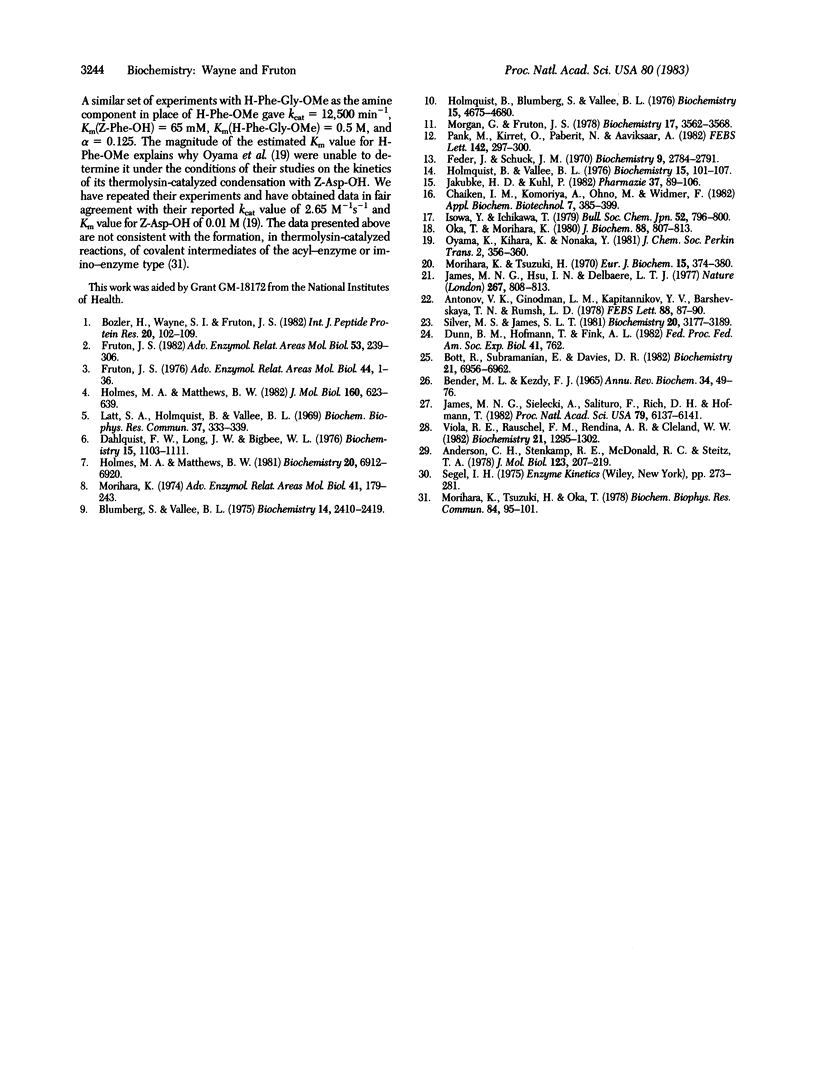Abstract
The rates of the thermolysin-catalyzed synthesis of peptides have been determined by means of HPLC. In the condensation of various N-substituted amino acids and peptides with L-leucinanilide, the enzyme exhibits preference for a hydrophobic L-amino acid as the donor of the carbonyl group of the newly formed bond. The presence of another hydrophobic amino acid residue adjacent to the carbonyl-group donor markedly enhances the rate of synthesis. In general, the effect of structural changes in both the carboxyl and amine components of the condensation reaction is in accord with the available data on the primary and secondary specificities of the thermolysin-catalyzed hydrolysis of oligopeptide substrates. A kinetic study of the condensation of benzyloxycarbonyl-L-phenylalanine with various amine components has given data on the apparent kcat and Km values for the entry of the acidic component into the condensation reaction. The results are consistent with the behavior of rapid-equilibrium random bi-reactant systems leading to ternary enzyme-substrate complexes, with a synergistic effect in the binding of the two reactants at the active site. Because the changes in the apparent kcat for the entry of the same acidic component into reaction with different amine components are greater than those in the apparent Km, it is suggested that this synergism is largely expressed at the level of the transition-state complex.
Full text
PDF



Selected References
These references are in PubMed. This may not be the complete list of references from this article.
- Anderson C. M., Stenkamp R. E., McDonald R. C., Steitz T. A. A refined model of the sugar binding site of yeast hexokinase B. J Mol Biol. 1978 Aug 5;123(2):207–219. doi: 10.1016/0022-2836(78)90321-2. [DOI] [PubMed] [Google Scholar]
- Antonov V. K., Ginodman L. M., Kapitannikov Y. V., Barshevskaya T. N., Gurova A. G., Rumsh L. D. Mechanism of pepsin catalysis: general base catalysis by the active-site carboxylate ion. FEBS Lett. 1978 Apr 1;88(1):87–90. doi: 10.1016/0014-5793(78)80613-9. [DOI] [PubMed] [Google Scholar]
- BENDER M. L., KEZDY J. MECHANISM OF ACTION OF PROTEOLYTIC ENZYMES. Annu Rev Biochem. 1965;34:49–76. doi: 10.1146/annurev.bi.34.070165.000405. [DOI] [PubMed] [Google Scholar]
- Blumberg S., Vallee B. L. Superactivation of thermolysin by acylation with amino acid N-hydroxysuccinimide esters. Biochemistry. 1975 Jun 3;14(11):2410–2419. doi: 10.1021/bi00682a022. [DOI] [PubMed] [Google Scholar]
- Bott R., Subramanian E., Davies D. R. Three-dimensional structure of the complex of the Rhizopus chinensis carboxyl proteinase and pepstatin at 2.5-A resolution. Biochemistry. 1982 Dec 21;21(26):6956–6962. doi: 10.1021/bi00269a052. [DOI] [PubMed] [Google Scholar]
- Bozler H., Wayne S. I., Fruton J. S. Specificity of pepsin-catalyzed peptide bond synthesis. Int J Pept Protein Res. 1982 Aug;20(2):102–109. doi: 10.1111/j.1399-3011.1982.tb02660.x. [DOI] [PubMed] [Google Scholar]
- Dahlquist F. W., Long J. W., Bigbee W. L. Role of Calcium in the thermal stability of thermolysin. Biochemistry. 1976 Mar 9;15(5):1103–1111. doi: 10.1021/bi00650a024. [DOI] [PubMed] [Google Scholar]
- Feder J., Schuck J. M. Studies on the Bacillus subtilis neutral-protease- and Bacillus thermoproteolyticus thermolysin-catalyzed hydrolysis of dipeptide substrates. Biochemistry. 1970 Jul 7;9(14):2784–2791. doi: 10.1021/bi00816a005. [DOI] [PubMed] [Google Scholar]
- Fruton J. S. Proteinase-catalyzed synthesis of peptide bonds. Adv Enzymol Relat Areas Mol Biol. 1982;53:239–306. doi: 10.1002/9780470122983.ch7. [DOI] [PubMed] [Google Scholar]
- Fruton J. S. The mechanism of the catalytic action of pepsin and related acid proteinases. Adv Enzymol Relat Areas Mol Biol. 1976;44:1–36. doi: 10.1002/9780470122891.ch1. [DOI] [PubMed] [Google Scholar]
- Holmes M. A., Matthews B. W. Binding of hydroxamic acid inhibitors to crystalline thermolysin suggests a pentacoordinate zinc intermediate in catalysis. Biochemistry. 1981 Nov 24;20(24):6912–6920. doi: 10.1021/bi00527a026. [DOI] [PubMed] [Google Scholar]
- Holmes M. A., Matthews B. W. Structure of thermolysin refined at 1.6 A resolution. J Mol Biol. 1982 Oct 5;160(4):623–639. doi: 10.1016/0022-2836(82)90319-9. [DOI] [PubMed] [Google Scholar]
- Holmquist B., Blumberg S., Vallee B. L. Superactivation of neutral proteases: acylation with N-hydroxysuccinimide esters. Biochemistry. 1976 Oct 19;15(21):4675–4680. doi: 10.1021/bi00666a021. [DOI] [PubMed] [Google Scholar]
- Holmquist B., Vallee B. L. Esterase activity of zinc neutral proteases. Biochemistry. 1976 Jan 13;15(1):101–107. doi: 10.1021/bi00646a016. [DOI] [PubMed] [Google Scholar]
- James M. N., Hsu I. N., Delbaere L. T. Mechanism of acid protease catalysis based on the crystal structure of penicillopepsin. Nature. 1977 Jun 30;267(5614):808–813. doi: 10.1038/267808a0. [DOI] [PubMed] [Google Scholar]
- James M. N., Sielecki A., Salituro F., Rich D. H., Hofmann T. Conformational flexibility in the active sites of aspartyl proteinases revealed by a pepstatin fragment binding to penicillopepsin. Proc Natl Acad Sci U S A. 1982 Oct;79(20):6137–6141. doi: 10.1073/pnas.79.20.6137. [DOI] [PMC free article] [PubMed] [Google Scholar]
- Latt S. A., Holmquist B., Vallee B. L. Thermolysin: a zinc metalloenzyme. Biochem Biophys Res Commun. 1969 Oct 8;37(2):333–339. doi: 10.1016/0006-291x(69)90739-6. [DOI] [PubMed] [Google Scholar]
- Morgan G., Fruton J. S. Kinetics of the action of thermolysin on peptide substrates. Biochemistry. 1978 Aug 22;17(17):3562–3568. doi: 10.1021/bi00610a022. [DOI] [PubMed] [Google Scholar]
- Morihara K. Comparative specificity of microbial proteinases. Adv Enzymol Relat Areas Mol Biol. 1974;41(0):179–243. doi: 10.1002/9780470122860.ch5. [DOI] [PubMed] [Google Scholar]
- Morihara K., Tsuzuki H., Oka T. Acyl and amino intermediates in reactions catalyzed by thermolysin. Biochem Biophys Res Commun. 1978 Sep 14;84(1):95–101. doi: 10.1016/0006-291x(78)90268-1. [DOI] [PubMed] [Google Scholar]
- Morihara K., Tsuzuki H. Thermolysin: kinetic study with oligopeptides. Eur J Biochem. 1970 Aug;15(2):374–380. doi: 10.1111/j.1432-1033.1970.tb01018.x. [DOI] [PubMed] [Google Scholar]
- Oka T., Morihara K. Peptide bond synthesis catalyzed by thermolysin. J Biochem. 1980 Sep;88(3):807–813. doi: 10.1093/oxfordjournals.jbchem.a133034. [DOI] [PubMed] [Google Scholar]
- Pank M., Kirret O., Paberit N., Aaviksaar A. Hydrophobic interaction in thermolysin specificity. FEBS Lett. 1982 Jun 7;142(2):297–300. doi: 10.1016/0014-5793(82)80156-7. [DOI] [PubMed] [Google Scholar]
- Silver M. S., James S. L. Enzyme-catalyzed condensation reactions which initiate rapid peptic cleavage of substrates. 1. How the structure of an activating peptide determines its efficiency. Biochemistry. 1981 May 26;20(11):3177–3182. doi: 10.1021/bi00514a029. [DOI] [PubMed] [Google Scholar]
- Viola R. E., Raushel F. M., Rendina A. R., Cleland W. W. Substrate synergism and the kinetic mechanism of yeast hexokinase. Biochemistry. 1982 Mar 16;21(6):1295–1302. doi: 10.1021/bi00535a029. [DOI] [PubMed] [Google Scholar]


